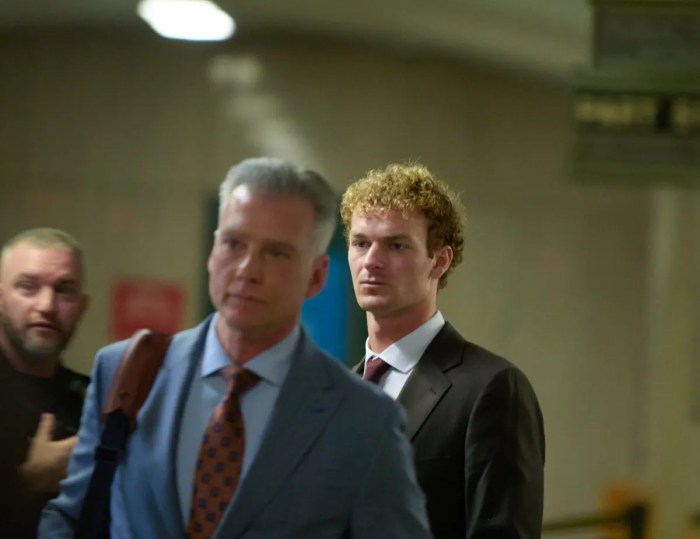By Jennifer Warren
Located in a small brick building on the campus of Queens Hospital Center at 62-68 164th St. in Jamaica since 1939, the mortuary, under the watch of Donna Wilson-Chea and Mitchell, receives some 6,000 bodies from the borough, on way to burial, each year.
Mitchell, a man of sturdy build with graying hair and confident ease, often pleads a poor memory when asked to recall a story or two.
“There are so many,” Mitchell said recently during a visit. But when pressed he tells a tale worthy of Edgar Allen Poe's own pages.
Several years ago a decapitated man's body was brought in. The man had been wandering by the train tracks and whether by suicide or accident, his head was severed by a passing train. When the doctor performing the autopsy opened the man's chest, she found it lacked a heart. There were no external injuries to the chest, simply a headless body without a heart.
“No one could figure out what had happened,” Mitchell said.
It was two days later when the morgue learned that a young child had been with the man when he died. They determined the force of impact contracted the man's neck muscles and suctioned the heart from his torso through his neck. The child, who was a relative of the man, had found the heart lying by the tracks and brought the heart home with him, Mitchell said cupping his hands while he spoke, as if holding the expunged organ.
While most of the cases they receive are not nearly as eerie, the morgue, staffed by 15 technicians and five medical examiners, takes in between one and 40 bodies each week. The bodies come from hospitals, from nursing homes, from private houses, from crime scenes all over Queens. They are the people who were not claimed by a family member and for whom burial arrangements have yet to be made.
Wilson-Chea, the coordinating manager, estimated that five bodies at most remain unclaimed each week. And while every body is examined, photographed and fingerprinted, only those that remain unclaimed after about 30 days are interred in the potter's field.
The identification routine has, in fact, changed little since New York City's first morgue opened in 1866 at Bellevue Hospital on 26th Street in Manhattan. There, unclaimed bodies were also photographed, but rather than taking fingerprints 19th century technicians opted for retaining the deceased's clothing.
The Police Department's Missing Persons Unit, based within the Queens morgue, handles the photographing and fingerprinting of the bodies. The unit's sergeant and five detectives work on most of the morgue's cases, their duties ranging from tracking down the deceased's family to observing the autopsy of a homicide victim.
Not every body is fully autopsied, however. Those who have had a medical examination within 30 days and whose external exam reveals nothing suspicious and those whose religion forbid an autopsy receive an external exam only. But for the rest – on average 60 percent of the caseload – a full autopsy is performed.
The morgue itself looks much like a salmon-colored locker room. Noticeably cool, the room has a large round thermostat placed high on the wall like a grade-school clock points its hand to just below 40 degrees Fahrenheit, a temperature that will slow the body's decomposition but avoid freezing it. Even so, the air is saturated with the tang of formaldehyde and decay.
The warm-toned walls are lined with 89 stainless steel drawers, stacked in rows of three. Each drawer has a handle and a square slot to insert a label. It is not unlike an oversized card catalog.
“The heaviest people go in the middle. The light go on top,” Donna Wilson-Chea said, explaining that the arrangement makes for easier lifting for the technicians.
When autopsied, the body is placed on a table, its chest raised with the aid of a brick-sized block beneath the back, and the chest opened with a Y-cut incision running from each shoulder to the sternum, and down to the abdomen. The skin is peeled back and the breast plate removed, after which samples of major organs are taken and sent to the toxicology lab for testing.
But the staff's work is as much with the living as with the dead.
Lugene Nelom, who has been a technician with the morgue for 10 years, said one case particularly resonated with him. One evening, he went to retrieve the body of a woman. When he removed her body, the woman's husband approached Nelom.
“'Please take care of my wife for me,' the husband said. The next thing you know, he was hugging me.” Nelom did care for the body, and months later received a letter from the man thanking him.
“I tell my guys not to get involved,” Wilson-Chea said, “because that's not our side of it. But some days you just feel like you want to help the families. I've done it myself.”
Nelom, a large bearlike man with tired eyes, is sometimes struck by the tragedy of his job, especially when he retrieves the body of a child. He suspended his curled arms out before him, as if supporting a small corpse, and described the time he found the body of a baby not yet a year old. That night he returned home to hug his own baby.
“It makes you appreciate the life you have,” Wilson-Chea said “- good, bad, or indifferent.”

































